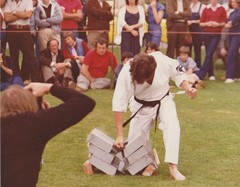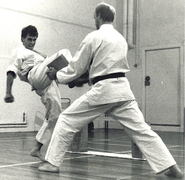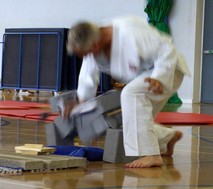Tameshiwari
In the ‘new-world order’ of the H&S and the political correctness police, etc., we have seen, over the years, a total eradication of elements of our martial-arts disappear one by one. No more bladed weapons in the Dojo, paranoid warm-up procedures, mats, padding, risk assessments, anything and everything to make martial-arts conform to a process of aerobic exercises that eliminate the fundamental values of ‘survival’ – which is (or was) the reason martial-arts came into being in the first place – or have I missed something here?
Makiwara and body conditioning are among the latest elements that will, I am sure, be targeted by the Nanny-State Brigade, if they haven’t already started their march on it.
Breaking techniques? Goodness me! Be careful, you may scratch your nail-varnish! Oops, I think some dust got into my eye….!
Gary E Swift Hanshi.
About Makiwara and Tameshiwari
|
Hironori Ohtsuka Meijin Demonstrates Makiwara
|
Wolff’s Law and its effects with Makiwara and Tameshiwari, as an aid for the Karate-ka. As you practise more Makiwara and Tameshiwari your hands will go through what is known as a ‘wolffing effect’ (Wolff’s Law), which means that the bone will break microscopically and then harden (bones are like honeycomb so will crumble, under shock and stress, then strengthen to harden and become less honeycombed). Wolff’s law is a theory developed by the German Anatomist/Surgeon Julius Wolff (1836–1902) in the 19th century that states that bone in a healthy person or animal will adapt to the loads it is placed under.
If loading on a particular bone increases, the bone will remodel itself over time to become stronger to resist that sort of loading. The internal architecture of the trabeculae undergoes adaptive changes, followed by secondary changes to the external cortical portion of the bone, perhaps becoming thicker as a result. The converse is true as well: if the loading on a bone decreases, the bone will become weaker due to turnover, it is less metabolically costly to maintain and there is no stimulus for continued remodelling that is required to maintain bone mass.
TAMESHI-WARI – ‘Test breaking’ or ‘test exercise’. In Karate the exponent will test his own ability by attempting to break, either barehanded or barefooted, such items as; wood, brick, and tiles etc. It is no doubt that we have all seen Karate-ka breaking all sorts of objects from wood, ice, bricks and even chopping the top off bottles while leaving the bottle standing. But there is a question, is this flashy showmanship or has it a benefit to the martial artist; here there remains a difference of opinion within Karate. All should agree that Karate-ka should be capable of such feats and that it is merely the natural outcome of properly executed techniques. Some styles however believe it is just showmanship and whilst they may use it for the odd demonstration it is rarely used in the dojo. On the other hand there are styles, notably Kyokushinkai that require their members to break a specified thickness of wood before being permitted to take part in certain competitions or prior to being promoted to the related grade, this is used not only to provide proof that the joints can withstand impact, but also of the Karate-ka’s psychological commitment to the blow.
So what does Tameshiwari mean?
Tameshi in fact means ‘trial’ or ‘test’ and Wari means ‘break’, so Tameshiwari is therefore ‘test break’. This does suggest that there is some other benefit to this practice other than flashy showmanship after all ‘boards don’t hit back’.
It is claimed by styles like Kyokushinkai that Tameshiwari is a physical and psychological necessity for Karate-ka and that it possesses a spiritual (Zen) significance. Tameshiwari requires great concentration and focus and is as much, if not more a mental as well as a physical effort. If one believes oneself of being capable of breaking an object then one can release one’s entire physical energies into the act. Any mental reservations, such as being concerned of hitting something hard or what if the wood doesn’t break will inhibit the maximum use of power and potential of the technique.
The other argument for Tameshiwari is that the self-discipline required for such a strike is more a strike at one’s self than the wood. The total commitment, concentration and absorption in the action is such that the Karate-ka’s ego can be temporarily obliterated, he/she transcends their normal nature and momentarily enters the Zen world of nothingness. In this context Tameshiwari can provide ‘enlightenment through a single blow’ in what amounts to active Zen meditation.
I’ll leave you to weigh up the ‘pro’s & con’s’ for the benefit of this practice, but would like to point out that it is Extremely Dangerous for an untrained person to attempt Tameshiwari. Improperly executed, and without adequate training and conditioning, it can lead to serious injury.



